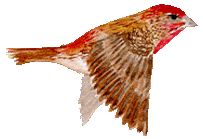|
Hey, Bird, You see a flash of color and suddenly a bird you
never saw before lands on a bush next to you. What is it? What do you need
to look for to indentify this bird? Here's your crash course, Bird ID 101,
on how to identify the birds you see. First of all you will need a good field guide. Then you will need to take careful mental notes. Ask yourself some questions. It seems like a lot of questions to ask but you will be surprised after a little practice how quickly you can run through them while observing a bird. What size is the bird? Guessing its size in inches is difficult, but compare, is it bigger than a sparrow? Smaller than a pigeon? What is its shape? Is is round like a robin? Slender like a mockingbird? What other birds does it act like? Does its tail go up like a wren or down like a flycatcher? Does it climb trees? If so does it climb upwards in spirals like a creeper or downwards like a nuthatch? Does it feed on the ground? If so does it walk like a blackbird or hop like a jay?
Is the bird one solid color? Are there large patches of different colors? Is there streaking of color on the breast? Now look at the bird's head. Take note of any color patterns around the eye. Is there a line through the eye? Around the eye? Does the bird have a crest? What kind of bill does the bird have? Is it thin like a wren? Thick like a cardinal? Or curved like a creeper? Now look for patterns on the wings and tail. Is there a shoulder patch? Do you see wing bars? Does the bird have patterns of color on its tail? Now ask all these questions while the bird is in flight. The wing and tail patterns become more noticable while the bird is flying. Does the bird have a rump-patch? Many birds are easily identified from the distictive color of their rump-patch. Are the wings pointed like a swallow? Or rounded like a bobwhite? Is the tail forked like a swallow? Rounded like a jay? Or pointed like a mourning dove? While you have the bird in view notice as much as you can about it. If you run for your field guide before you look at the bird it may be gone before you get back. Instead, enjoy the view, take mental notes. When you are finished then try to identify it. If you have trouble, rule out what you know the bird is not. The small bird that you saw at your feeder is not a seagull or a heron. Look in your guide at the family of the bird you saw. Then you can find the bird that looks like the bird at your feeder.
If you look through your field guide even when there are no birds around you will become familiar with what the different families of birds look like and act like and it will be easier to narrow down your choices when trying to identify a bird. Next time you see a bird. Run through these questions
in your mind, take mental notes and, once the bird has given you all the
information you can get, then go for the field guide. You'll have those
birds' IDs in no time. Take the Trail Back to Songbird Meadows This page is hosted by Geocities. See them today to get your free home page! |



